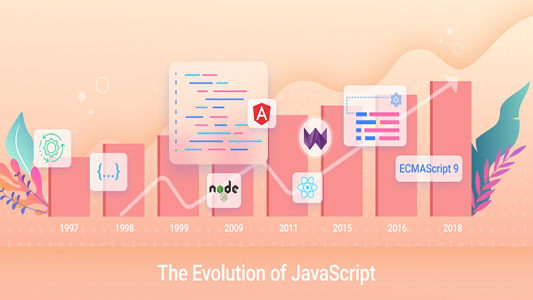
JavaScript is one of the most popular programming languages today. It has survived a long way of changes and updates to the point we know it today. Let’s have a look at the most important milestones in its development.
- The Mosaic Web Browser was released in 1993. It was the first publicly available browser with a graphical interface.
- Prior to 1995, HTML was mostly utilized to create web pages. The pages were static.
- Brendan Eich, a Netscape engineer, chose to mix the Java, Scheme, and Self programming languages in 1995 to develop the original version of JavaScript as we know it today.
Java Script was created in just 10 days. It was first known as Mocha, then as LiveScript, and eventually as JavaScript. Its name resemblance to the Java programming language led to the new language’s initial success.
JavaScript 1.0 was well received by users; thus, Netscape chose to include version 1.1 in Netscape Navigator 3.0. In its turn, Microsoft published Internet Explorer 3.0 and a new JavaScript version. They dubbed it Jscript to avoid any potential license concerns with Netscape. Overall, three JavaScript versions were released:
- JavaScript in Netscape Navigator
- JScript in Internet Explorer
- CEnvi in ScriptEase
Let’s travel back in time a little. Initially, there were no standards for programming languages. However, the growing use of computers from multiple manufacturers revealed the necessity for consistency in operating approaches such as programming and input and output codes. Data developed on one manufacturer’s computer might be utilized on another manufacturer’s computer with very minor modifications. It would also cut down on redundancy in the development of new programming languages. That is why, on April 27, 1960, a manufacturer’s association known as the European Computer Manufacturers Association, or ECMA, was formed in Brussels. A committee was created to develop the association’s foundation as well as write rules and standards.
As for the JavaScript language, in 1997, it was modified to meet the criteria of ECMA. There are two main JS standards:
- ECMA-262
- ISO/IEC 16262, hosted by IEC (the International Electrotechnical Commission) and ISO (the International Organization for Standardization)
JavaScript refers to the programming language, while ECMAScript reveals the versions and updates of the language.
| Year of edition | Name | The features that were added |
| 1997 | ECMAScript 1 | First edition |
| 1998 | ECMAScript 2 | Some version modifications |
| 1999 | ECMAScript 3 | ○ Regular expressions fully supported in all browsers
○ Try/catch |
| ECMAScript 4 | Not released | |
| 2009 | ECMAScript 5 | ○ JSON support
○ “strict mode” ○ String.trim() ○ Array.isArray() ○ Added Array iteration methods |
| 2011 | ECMAScript 5.1 | Some version modifications |
| 2015 | ECMAScript 6 | ○ Default parameter values
○ let and const ○ Array.find() ○ Array.findIndex() |
| 2016 | ECMAScript 7 | ○ Array.prototype.includes
○ Exponential operator (**) |
| 2017 | ECMAScript 8 | ○ New Object properties
○ String padding ○ Shared memory ○ Async functions |
| 2018 | ECMAScript 9 | ○ Asynchronous iteration ○ rest / spread properties ○ Additions to RegExp ○ Promise.finally() |
| 2019 | ECMAScript 10
|
○ Array methods .flatMap()
○ Optional catch call ○ JSON superset |
| 2020 | ECMAScript 11
|
○ Optional sequence operator
○ Zero Merge operator ○ BigInt |
| 2021 | ECMAScript 12
|
○ Logical assignment operator
○ String.prototype.replaceAll() ○ Promise.any() and AggregateError |
| 2022 | ECMAScript 13
|
○ Checking private fields
○ Using await at the top level of the module ○ Indexes in regular expression match objects |
JavaScript Frameworks
The evolution of the JS language cannot be separated from the development of various frameworks and libraries. A new JS framework or library appears on a regular basis. We will recall the first and most significant ones. Frameworks and libraries contain ready-made components and elements that developers can use in creating apps. It significantly facilitates and speeds up the process of building applications. Besides, the most well-known frameworks have wide communities of developers, which provides newcomers with an opportunity to learn fast and to benefit from their peers’ experience.
- Dynamic HTML was the first JavaScript framework (DHTML). It debuted in the year 2000. DHTML was first used to help with the alteration of online pages.
- The Node.js and AngularJS were released in 2009. Node.js is an open-source server-side programming platform for generating real-time apps. Angular is a structural JavaScript framework that aids in the development of dynamic web applications.
- Meteor and Knockout first emerged in 2013. JavaScript’s climb to popularity was facilitated by these frameworks. React also appeared in 2013, and it is now one of the most successful and extensively used JS libraries.
- The Webix UI library was also launched in 2013. It has matured greatly since that time, offering complex ready-made SPAs, as well as a built-in microframework, a UI Designer, templates, Code Snippet, Skin Builder, and Form Builder.
Conclusion
JavaScript has undergone a serious process of evolution. Today, it is a widely used language for creating web applications and websites of any complexity that are interactive and user-friendly. It is on the list of required skills for developers’ positions in any IT company. So, if you’re still undecided about what to learn first, JavaScript will undoubtedly come in handy.
